|
Page < 1 2 3 >
Creation
Hinduism is the only religion that propounds the idea
of life-cycles of the universe. It suggests that the universe undergoes an
infinite number of deaths and rebirths. As
in modern physics, Hindu cosmology envisaged the universe as having a cyclical
nature. The end of each kalpa brought about by Shiva's dance is also the
beginning of the next. Rebirth follows destruction.
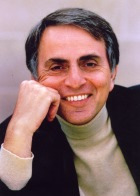 Hinduism, according to Carl
Sagan,
in his book, Cosmos wrote: Hinduism, according to Carl
Sagan,
in his book, Cosmos wrote:
"... is the only religion in which the time scales
correspond... to those of modern scientific cosmology. Its cycles run from our
ordinary day and night to a day and night of the Brahma, 8.64 billion years
long, longer than the age of the Earth or the Sun and about half the time since
the Big Bang"
Long before Aryabhata
(6th century) came up with this awesome achievement, apparently there was a
mythological angle to this as well -- it becomes clear when one looks at the
following translation of Bhagavad Gita (part
VIII, lines 16 and 17),
"All the planets
of the universe, from the most evolved to the most base, are places of
suffering, where birth and death takes place. But for the soul that reaches my
Kingdom, O son of Kunti, there is no more reincarnation. One day of Brahma is
worth a thousand of the ages [yuga] known to humankind; as is each
night."
Thus each kalpa is worth one day in the life of
Brahma, the God of creation. In other words, the four ages of the mahayuga
must be repeated a thousand times to make a "day ot Brahma", a unit of
time that is the equivalent of 4.32 billion human years, doubling which one gets
8.64 billion years for a Brahma day and night. This was later theorized
(possibly independently) by Aryabhata in the 6th century. The cyclic nature of
this analysis suggests a universe that is expanding to be followed by
contraction... a cosmos without end. This, according to modern physicists is not
an impossibility.
(source:
Astronomy
and Mathematics in Ancient India).
Watch
Carl
Sagan and Hindu cosmology – video
Dr.
Sagan in his book Broca's
Brain: Reflections on the Romance of Science,
remarks:
"Immanuel
Velikovsky
(the author of Earth in
Upheaval) in his book Worlds
in Collision, notes that the idea of four ancient
ages terminated by catastrophe is common to Indian as well as to
Western sacred writing.
However,
in the Bhagavad
Gita and in the Vedas,
widely divergent numbers of such ages, including an infinity of
them, are given; but, more interesting, the duration of the ages
between major catastrophes is specified as billions of years. .. "
"The
idea that scientists or theologians, with our present still puny
understanding of this vast and awesome cosmos, can comprehend the
origins of the universe is only a little less silly than the idea
that Mesopotamian astronomers of 3,000 years ago – from whom the
ancient Hebrews borrowed, during the Babylonian captivity, the
cosmological accounts in the first chapter of Genesis – could
have understood the origins of the universe. We simply do not
know.
The
Hindu holy book, the Rig
Veda (X:129), has a much
more realistic view of the matter:
“Who
knows for certain? Who shall here declare it?
Whence was it born, whence came creation?
The gods are later than this world’s formation;
Who then can know the origins of the world?
None knows whence creation arose;
And whether he has or has not made it;
He who surveys it from the lofty skies,
Only he knows- or perhaps he knows not."
(source:
Broca's
Brain: Reflections on the Romance of Science - By Carl Sagan
p. 106 - 137).
Hinduism is not a single religion, rather it is a
multifaceted matrix of beliefs, philosophies, practices, myths and epics. Within
this matrix there are many myths of cosmogenesis. The Sanskrit word for creation is
srishti, which means
projecting a gross thing from a subtle substance. Srishti does not mean bringing
out existence from non-existence or creating something from nothing. Creation
implies something arising from nothing, or non-existence becoming existence.
Hindus declare that non-existence can never be the source of creation. Thus, the
universe is more accurately said to be the projection of the Supreme Being
rather than a creation.
To
the Vedic sages, creation indicated that point before which there was no
Creator, the line between indefinable nothingness and something delineated by
attributes and function, at least. Like the moment before the Big Bang Theory.
These concepts preoccupy high wisdom, the Truth far removed from mere religion. The
Bible begins with the Creation. Before the Creation, however, there was the
Creator, but does even He know
what was there before He existed ?
Long before such philosophical questions occurred to
other historical peoples, Vedism posited the existence of something more ultimate than
the one God. Whatever must have created Him. That is
presuming the absolute and basic reality. Or is it?
Hymn 129 of the Rig Veda
speaks:

Hymn 109 says:
" Then neither Being nor not-Being existed, neither
atmosphere, nor the firmament, nor what is above it . . . The One breathed
windless by its own power. Nought else but this existed then.
In the beginning was darkness swathed in darkness:
all this was but unmanifested water. Whatever was, that One coming into being,
hidden by the void, was generated by the power of heat.
In the beginning desire which was the first seed of
mind overcovered it. Wise seers, searching in their hearts, found the bond of
Being in Not-Being . . ."
(Rig Veda
- translated by
Ralph Griffith 575 - 6).
In this hymn the One, may refer to the creator
god Brahma, his breathing and desire bring the world into existence. Before this
was a void which can be described only by a paradox, Being nor Not-Being.
Creation accounts in the Vedas speak of a cosmic egg or
embryo from which " the lord of creation" was born as the great oceans
heated up. But later hymns were increasingly skeptical of such symbolism; the
tenth book of the Rig Veda
includes a verse asking,
"Who truly knows, who
could here declare when was born, whence comes this creation?'
Cyclic Creation
In one of the story of
The Upanishads,
referred to by
Joseph Campbell in his series of interviews with Bill Moyers, Brahma is the
creative force behind a series of universes:
Brahma sits on a lotus, the symbol of divine energy and
divine grace. The lotus grows from the navel of Vishnu. who is the sleeping
god, whose dream is the universe. . . . Brahma opens his eyes and a world come
into being . . . Brahma closes his eyes, and a world goes out of being.
(Campbell 63)
This story is similar to some modern ideas on the
creation of the universe in continuous cycle, like the one proposed by John
Wheeler,
all constants and laws of previous cycles are lost at the end of the
contracting phase, and new universes can be created in an infinite number
of cycles.
(Artwork
courtesy of The Bhaktivedanta Book Trust International, Inc. www.krishna.com).
Princeton
University’s Paul Steinhardt
and Cambridge University’s Neil Turok,
have recently developed The Cyclical Model.
They
have just fired their latest
volley at that belief, saying there could
be a timeless cycle of expansion and contraction. It’s an idea as
old as Hinduism, updated for the 21st century. The
theorists acknowledge that their cyclic concept draws upon religious
and scientific ideas going back for millennia — echoing the
"oscillating universe" model that was in vogue in the
1930s, as well as the Hindu belief that the universe has no
beginning or end, but follows a cosmic cycle of creation and
dissolution.
(source: Questioning
the Big Bang
- msnbcnews.com).
A 9th century Hindu scripture, The Mahapurana
by Jinasena claims the something as modern as the
following: (translation from [5])
"Some foolish men declare that a Creator made the world. The
doctrine that the world was created is ill-advised, and should be
rejected. If God created the world, where was he before
creation?... How could God have made the world without any raw
material? If you say He made this first, and then the world, you
are faced with an endless regression... Know that the world is
uncreated, as time itself is, without beginning and end. And it is
based on principles."
(source:
Astronomy
and Mathematics in Ancient India).
(Refer
to Visions
of the End of the World - By Dr. Subhash Kak -
sulekha.com).
For
more refer to The
Infinitesimal Calculus: How and Why it Was Imported into Europe
- By C. K. Raju and
Computers, mathematics
education, and the alternative epistemology of the calculus in the
Yuktibhâsâ
- By C. K. Raju
Continuous Creation
Another view of creation expressed in Hindu literature
is the idea that being is
eternal. The universe was not created, it will not be
destroyed. It simply is.
This selection from the second teaching of the
Bhagavad-Gita,
speaks of this type of creation:
"Indestructible is the presence that pervades all this;
no one can destroy this unchanging reality. It is not born, it does not die;
having been, it will never not be; unborn, enduring, constant, and primordial,
it is not killed when the body is killed."
The beauty as well as the horror of this ground of being
is revealed to Arjuna later in the Gita when Krishna reveals his true
form as the god Vishnu. Vishnu is usually referred to as the preserver, the
background behind all being. Stephen
Hawking in describing his mathematical model of the universe has used a
similar description.
Whereas in Western religions a creator god precedes man
and the universe, the Hindu gods are preceded by creation; the origin of the
world is envisaged not so much as an act of creation but as one of organization,
the making of order out of chaos. The universe is often said to be born from the
sacred syllable Om, or from an inert void in which " there was neither
being nor non-being ... death nor non-death", a single principle from which
emerged the diversity of life. From this void desire was born, and from desire
came humans, gods and creation."
(Note: For more on yugas, refer
to One
Cosmic Day of Creator Brahma.
Refer
to A
Map of Sacred Stories of the Ancient World
-
Contributed to this site by Dom Sturiale of Sydney, Australia.
Refer
to The
World of Myth - By Ramesh N Rao - sulekha.com).
Top of Page
Maya or Illusion
For many thousands of years, it is
argued, the mystics have had a cosmological and epistemological view
of things that the Western world is just beginning to understand.
Cosmologically, Western science has understood only recently that the
universe is extremely old. In 1965 the temperature of the universe was
measured for the first time, resulting in our present estimate of the
age of the universe as 15 billion years old. In the ancient literature
of the India one does not, of course, find such precise figures.
Instead there are analogies such as the following. Imagine an immortal
eagle flying over the Himalayas only once every 1,000 years; it
carries a feather in its beak and each time it passes, it lightly
brushes the tops of the gigantic mountain peaks. The amount of time it
would take the eagle to completely erode the mighty Himalayas is said
to be the age of the present manifestation of the universe. Such
a conception of time, which predates modern science by thousands of
years, is thought to be remarkable, especially when it is compared to
the slow realization of Western science and religion to the
possibility of a less humanlike time scale.
Eastern
mysticism is also consistent with the results of quantum physics. The
mystics have always rejected the idea of a hidden clocklike mechanism,
sitting out there, independent of human observation. The number one
truth is that reality does not consist of separate things, but is an
indescribable, interconnected oneness. Each object of our normal
experience is seen to be but a brief disturbance of a universal ocean
of existence. Maya is the illusion
that the phenomenal world of separate objects and people is the only
reality. For the mystics this manifestation is real, but it is a
fleeting reality; it is a mistake, although a natural one, to believe
that maya represents a fundamental reality. Each person, each physical
object, from the perspective of eternity is like a brief, disturbed
drop of water from an unbounded ocean. The goal of enlightenment is to
understand this--more precisely, to experience this: to see
intuitively that the distinction between me and the universe is a
false dichotomy. The distinction between consciousness and physical
matter, between mind and body, is the result of an unenlightened
perspective.
Maya (Sanskrit: "illusion") is a fundamental concept in Hindu philosophy, notably, in
the Advaita (Non-dualist) school of the orthodox system of Vedanta. Maya denotes
the power of wizardry with which a God can make human beings believe in what
turns out to be an illusion; by extension it later came to mean the powerful
force that creates the cosmic illusion that the phenomenal world is real.
Maya, as per Hindu thought, is illusion, and what
mankind understands to be reality is in fact the dream of Brahma. Brahma is the
creator and great magician who dreams the universe into being. The dream itself
is maintained by Vishnu, the Preserver, who uses maya to spin the complex web
that we know as reality. It is not that the world itself is an illusion, only our
perception of it. Whereas we suppose the universe to be made up of a multitude
of objects, structures and events, the theory of maya asserts that all things
are one. Rational categories are mere fabrications of the human mind and have no
ultimate reality.
In much of Hindu thought maya is illusion, and what
humankind understands to be reality is in fact the dream of Brahma. He is
the creator god and great magician who dreams the universe into being. The dream
itself is maintained by Lord Vishnu, the Preserver, who uses maya to spin the
complex web that we know as reality. It is not that the world itself is an
illusion, only our perception of it. Whereas we suppose the universe to be made
up of a multitude of objects, structures and events, the theory of maya asserts
that all things are one. Rational categories are mere fabrications of the human
mind and have no ultimate reality.
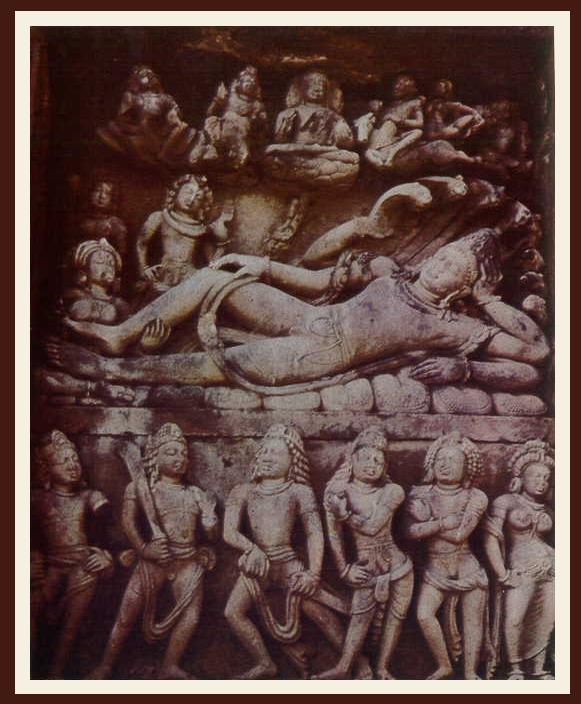
The
symbol is that of Ananta, the great Adisesha of infinity and
eternity, which is always represented, coiled up in a horizontal
figure of 8 just like the leminiscate.
Lord Vishnu is said to rest in the coils
of Ananta, the great serpent of Infinity, while he waits for the universe to
recreate itself.
***
Modern Indian spiritual teachers assert that if the
West had followed the Greek philosopher Heraclitus rather than Plato, the
history of ideas would be very different and the concept of maya would be
central to Western as well as to Eastern thought. Although Plato's teaching
resembles maya when he writes that "the visible world is a pale shadow of a
true reality beyond", he believed that each aspect of the world had a
separate, distinct identity. Heraclitus posited instead a theory which was based
on the assumption of the inseparable interconnectedness of the universe. His
theory of Becoming asserts that all things are in a state of constant flux;
always in the process of becoming something else. This hypothesis is echoed
today, some 2,500 years later, by Chaos Theory,
which the American science
writer James Gleick defined as "the science of process rather than state,
of becoming rather than being".
Maya is thus that cosmic force that presents the
infinite Brahman (the supreme being) as the finite phenomenal world. Maya is
reflected on the individual level by human ignorance (ajñana) of the real
nature of the self, which man has mistaken for the empirical ego but which is in
reality identical with Brahman.
So why does all this
worldly illusion exist?
Ramakrishna
called the world, "The Great Play of the Mother of the World." This is
the "play" of Matter--the material world. It is somewhat like a stage
play. We are all creatures of spirit with various coatings of matter hiding the
spirit from the light. As we act out our Karmic roles in this great play, we
remove the coatings of matter and release the light within us. The more light we
accumulate within us, the more we can see the light hidden in other people and
things. In reality, the whole world play exists for us to seek God
Consciousness. All people are either striving toward the light or hiding from
it. Those who are hiding are caught up in the Maya.
So, everything which has existence, everything in the
phenomenal world is Maya. It is safe to say that "Everything is Maya."
How does that affect us in our daily life? It affects the choices we make and
therefore the Karma we make for ourselves as a result of those choices. So how
should we deal with the Maya of existence? We should try to look for the Reality
behind the veils of Maya. Primal Energy is the Infinite Transcendental Essence
which permeates all existence. It is like Infinity in manifestation, if such a
thing were possible. But to carry this analogy further where it is more
understandable, we can best see everything in the universe as a differentiation
or gradation of Primal Energy.
Thus, at the root of all existence--all Maya--is
Primal Energy. Primal Energy is also the Great
Aum, "The Word," or
even God, if you will. Thus, when Hindus clasp their hands together and bow
towards each other, they are saying, in effect, "The God within me greets
the God within you."
Water of Illusion
The Greek philosopher Heraclitus used a river as an
analogy for his Theory of Becoming, teaching that one cannot step into the same
river twice. Maya, too, is often associated with water, the medium that forever
changes as it flows from place to place. Water is often a symbol and an agent of
illusion. When Lord Vishnu is compelled to lift the veils of maya for the
benefit of his followers, water is never far away.
A well-known Hindu parable
tells of a sage (Narada)
who underwent such rigorous penance that he felt entitled to
demand fro Lord Vishnu the secret of maya. The god responded by ordering the
mortal to dive into a nearby river. When the sage emerged, he did so as a woman,
oblivious of her former existence. After a lifetime of success and failure,
happiness and tragedy, she finally threw herself in despair onto the funeral
pyre of her husband who had been murdered. The fire was instantly quenched by
water. The sage regained his former body, and in that moment Lord Vishnu
appeared. " This is Maya," he said, and the sage came to understand
the nature of illusion and the workings of the universe.
(Refer
to Visions
of the End of the World - By Dr. Subhash Kak - sulekha.com).
Refer to A
Map of Sacred Stories of the Ancient World
- Contributed to this site
by Dom Sturiale of Sydney, Australia. Refer
to The
World of Myth - By Ramesh N Rao - sulekha.com).
Top of Page
Churning of the Milky Ocean or Samudra-Manthana
In this great
story of
Samudra-Manthana,
the Devas and
the Asuras, the bright and the dark powers, both combined to churn the milky
ocean to obtain the elixir of immortality. We do not have the absolute
dichotomy of good and evil that is there in the Semitic traditions; the bright
and dark powers, the Devas and the Asuras, are, in fact, related within the
whole theory of duality. Promising
them a share, they invited the demons (Asuras) to take the tail of the serpent
Vasuki, wrapped about the giant churning pole like a rope. The pole was fixed to
the bottom of the ocean and the waves it made in twisting one way and the other
way threatened to destroy the three worlds. Lord Vishnu incarnated himself as a
tortoise Kurma, taking the pole on his back to prevent the commotion. Glorious
treasures emerged from the churned milk: Kamadhenu, the all-giving cow;
Kalpavrksa, the wish-fulfilling tree; Accaisrava,
the divine horse; Airavata, the divine elephant; Mahalaxshmi, the goddess of
wealth and prosperity. These and other great gifts appeared and were happily
divided between Asuras and Devas. The ultimate objective was the pot of
ambrosia, the elixir of immortality, the amrta kalasa.
Suddenly, a terrible
poison the came forth. Lord Shiva, the great primal divinity, aloof from avarice
and materialism of the Devas and Asuras, appeared. He collected the poison in a
cup, and as he drank it his throat turned blue, hence one of the names of Shiva
is nilakantha, the blue-throated one.
Top of Page
Shiva Natarja (Cosmic Dance)
Throughout southern India, Lord Shiva is worshipped as
Shiva Nataraja, Lord of the Dance. In the words of
Ananda Coormaraswamy,
a
pioneering Hindu philosopher and historian of Indian art, Shiva's dance is the
"clearest
image of the activity of God which any art or religion can boast."
The image of Shiva as Nataraj is indelibly stitched into the Indian
imagination.
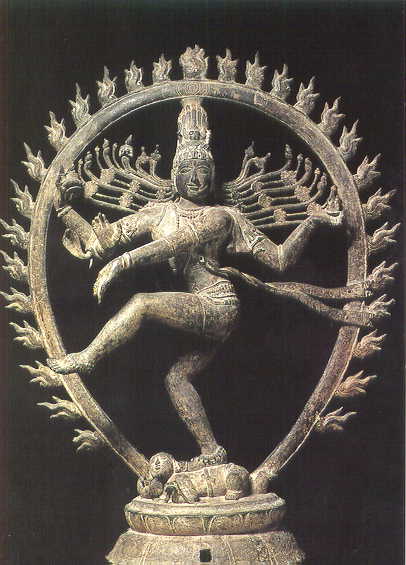
The dance
of Shiva is the dancing universe, the ceaseless flow of energy going through an
infinite variety of patterns that melt into one another’.
Lord Shiva, the cosmic dancer
-
an image that now stands
in the plaza of the European Organization for Nuclear Research in Geneva.
Hinduism the only religion whose time-scale for the universe matches the
billions of years documented by modern science.
***
 According to Sir
Jacob Epstein (1880-1959),
leading English Sculptor. After studying with Rodin in Paris, he revolted
against the ornate and pretty in art, producing bold, often harsh and massive
forms in stone and bronze. has written about
Shiva Nataraja: According to Sir
Jacob Epstein (1880-1959),
leading English Sculptor. After studying with Rodin in Paris, he revolted
against the ornate and pretty in art, producing bold, often harsh and massive
forms in stone and bronze. has written about
Shiva Nataraja:
"Shiva
dances, creating the world and destroying it, his large rhythms conjure up vast
aeons of time, and his movements have a relentless magical power of incantation.
Our European allegories are banal and pointless by comparison with these
profound works, devoid of the trappings of symbolism, concentrating on the
essential, the essentially plastic."
(source: Let
There Be Sculpture - By Sir Jacob Epstein 1942 p. 193).
The late scientist,
Carl
Sagan,
in his book, Cosmos
asserts that the
Dance
of
Nataraja (Tandava)
signifies the cycle of evolution and destruction of the cosmic universe (Big
Bang Theory).
"It is the clearest image of the activity of God which any
art or religion can boast of."
Modern physics has shown that the rhythm of
creation and destruction is not only manifest in the turn of the seasons and in
the birth and death of all living creatures, but also the very essence of
inorganic matter. "
For modern physicists, then, Shiva's dance is the dance of subatomic matter.
Hundreds of years ago, Indian artist created visual images of dancing Shiva's in
a beautiful series of bronzes. Today, physicist have used the most advanced
technology to portray the pattern of the cosmic dance. Thus, the metaphor of the
cosmic dance unifies, ancient religious art and modern physics.
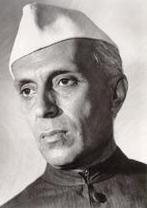 Shiva's
dance is a symbol of the unity and rhythm of existence. The unending, dynamic
process of creation and destruction is expressed in the energetic posture of
Shiva. He dances in a ring of fire that refers to the life-death process of the
universe. Everything is subject to continual change, as energy constantly
assumes new forms in the "play" (lila) of creation, except the god
himself whose dance is immutable and absolute. The pictorial allegory of
Nataraja indicates the so-called "five acts" of the deity: the
creation of the universe, its sustenance in space, its final dissolution at the
end of the cycle of four world ages (yugas), the concealment of the nature of
the godhead, and the bestowal of true knowledge.
Shiva's
dance is a symbol of the unity and rhythm of existence. The unending, dynamic
process of creation and destruction is expressed in the energetic posture of
Shiva. He dances in a ring of fire that refers to the life-death process of the
universe. Everything is subject to continual change, as energy constantly
assumes new forms in the "play" (lila) of creation, except the god
himself whose dance is immutable and absolute. The pictorial allegory of
Nataraja indicates the so-called "five acts" of the deity: the
creation of the universe, its sustenance in space, its final dissolution at the
end of the cycle of four world ages (yugas), the concealment of the nature of
the godhead, and the bestowal of true knowledge.
Jawaharlal Nehru
(1889-1964) first
prime minister of free India, was more than a deeply moral human
being. He yearned for spiritual light. He was particularly drawn
to Swami Vivekananda and the Sri Ramakrishna Ashram. In his book
- A Discovery of India he
wrote:
"The statue of Nataraja (dance pose of
Lord Shiva) is a well known example for the artistic, scientific and
philosophical significance of Hinduism."
(source:
A Discovery of India
- By Jawaharlal Nehru p.
214).
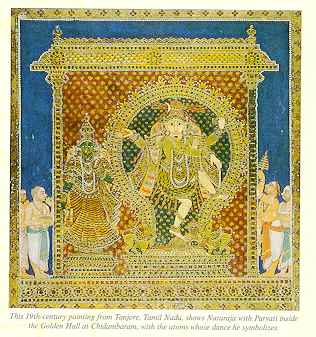
Shiva's
dance is a symbol of the unity and rhythm of existence. The unending, dynamic
process of creation and destruction is expressed in the energetic posture of
Shiva. He dances in a ring of fire that refers to the life-death process of the
universe.
***
 Fritjof
Capra (1939 - )
Austrian-born famous theoretical high-energy physicist and ecologist wrote: Fritjof
Capra (1939 - )
Austrian-born famous theoretical high-energy physicist and ecologist wrote:
"Modern physics has thus revealed that every subatomic
particle not only performs an energy dance, but also is
an energy dance; a pulsating process of creation and destruction. The
dance
of Shiva is the dancing universe, the ceaseless flow of energy going through an
infinite variety of patterns that melt into one another’’.
For the modern physicists, then Shiva’s dance
is the dance of subatomic matter. As in Hindu mythology, it is a continual dance
of creation and destruction involving the whole cosmos; the basis of all
existence and of all natural phenomenon. Hundreds of years ago, Indian artists
created visual images of dancing Shivas in a beautiful series of bronzes. In our
times, physicists have used the most advanced technology to portray the patterns
of the cosmic dance."
(source: The
Tao of Physics: An Exploration of the Parallels Between Modern Physics and
Eastern Mysticism - By Fritjof Capra p.
241-245).
The posture and balance of Nataraja's dancing form show Lord Shiva in the aspect
of tamas, the expansive centrifugal force that creates and destroys the
universe. This is the first of the three "tendencies" (gunas) that
permeate the universe in Samkhya philosophy. Tamas (darkness), symbolized by
Shiva, is responsible for the constant birth, change and death of all living
things; the force sattva (tranquility) represented by Vishnu the Preserver,
holds the atoms of every object together. These two "tendencies" - one
holding the atoms of the universe together and the other ripping them apart -
create a " friction " (rajas) that "vibrates" the
world's atoms and creates the gravity to hold them to the earth. This is the
third tendency, symbolized by the deity Brahma. It is the building stuff both of
matter and of subtle energies such as perception and thought.
Consciousness inhabits all living things and has
permeated the universe since it was created from its original bindu (energy
center). The first stave of the universe was filled by "space" : the
potential area in which the world will "expand" with the energy of
Shiva's aspect as tamas. At the end of Kali Yuga (the current age of ignorance),
the expansion accelerates, everything merges and Shiva performs the terrible
tandava dance of destruction.
The most important Shiva image during the
Chola dynasty
was that of
Shiva as Lord of the Dance, or Shiva Nataraja.
In this form, Shiva
is a summation of Indian religion, philosophy and culture. Shiva's dance is of
cosmic significance and represents five principle manifestations of eternal
energy: Creation, Destruction, Preservation, Salvation, and Illusion. He holds
in his upper right hand a small drum, the symbol of the sound of creation. In
his upper left hand is a flame representing the final destruction of the
universe. His lower right hand makes the gesture "fear not." With his
lower left hand he points to his raised left foot, the place of refuge and
salvation for the devotee. His right foot is planted on the back of the demon
Apasmara Purusha, the personifying illusion of ignorance over whom Shiva
triumphs. In Shiva's hairdo sits the river goddess Ganga, the personification of
the Ganges river which is said to spring forth from Shiva's head.
The dancing lord Shiva represents the constant process
of creation, preservation and destruction of the universe. He trods on the
dwarf, symbolic of Ignorance, which must be eliminated if a believer is to
attain release from the eternal cycle of birth and death. In Shiva's upper hands
are a drum, symbol of creation, and fire, symbol of destruction. This
magnificently modeled bronze image is a superb example of Chola workmanship.
The entire Universe is then engaged in movement and
endless activity, in an uninterrupted cosmic dance of energy. In Hindu
iconography the images that represent this dance are shown with Nataraja dancing
with four arms and waving hair and should be read as pictorial allegories.
The upper right hand holds a small drum shaped as a clepsydra, which according
to Zimmer keeps the rhythms of sound, the vehicle of the word transmitting
revelation tradition and enchantment. The opposite hand, on the top left,
with fingers postured as half moon, (ardhachandra mudra), carries a Flame, the
element of destruction of the world on the palm of the hand. In the
balance of the hands creation and destruction are shown as counterweights in the
game of the cosmic dance made evident even by the quietness and serenity of
Shiva's face at the centre between the two hands. The second right hand is
making the gesture of 'motto fear ' that gives peace and protection, while the
last left hand, suspended at the height of the breast, points toward the left
foot symbolising liberation from the enchantment of Maya.
Universally regarded as the quintessential
image of Hindu art and culture, representations of the god Shiva dancing in
joyous abandonment within a circle of flames graphically depict his five cosmic
acts of creation, preservation, destruction, unveiling of illusion, and
liberation of the soul. His creative aspect is symbolized by the
hourglass-shaped drum, in his proper upper right hand, which reproduces the
primordial sound of creation. Shiva’s preservation of the universe is
suggested by his lower right hand held in the gesture of reassurance and safety.
The flame in his upper left hand and that encircling the aureole represent the
fire by which he destroys the universe in order to recreate it. He lifts the
veil of illusion through his engendering act of dancing. His liberation of the
soul is shown by his upraised left leg, which tramples on a prostrate infant
signifying forgetfulness and is thus a source of grace.
While Shiva is believed to dance in various forms and
locales for differing purposes, in this pose as Lord of the Dance (Nataraja), he
is praised by the renowned eighteenth-century South Indian poet
Thayumanavar
as
performing the “Dance of Bliss in the Hall of Consciousness.”
The dance of
bliss is specifically associated with
Chidambaram, the sacred center of Nataraja worship,
where Shiva is said to have first performed it in order to convert a
group of holy men who were engaged in heretical practices. Chidambaram is also
the site of the great twelfth-century temple specifically dedicated to Shiva’s
aspect as Lord of the Dance. The temple has a silver image of the dancing god as
its main icon, and the gateway around the complex is adorned with sculpted
depictions of the 108 basic postures of classical Indian dance, Bharata Natyam,
which has been performed since at least the second century B.C.
South Indian copper alloy images such as this were
originally carried in processions during religious festivals; ropes were
inserted through the square holes in the base to tie it to support poles. The
distinctive elliptical shape of the aureole and slender figural style indicate
that it is one of the earliest surviving images of this type.
As Shiva
Nataraja, Lord of the Dance, Shiva
enacts the end of the world. He is the symbol of death but only of death as the
generator of life and as a source of that creative power ever renewed by
Vishnu
and Brahma.
He evokes the most intense adoration from
devotees for he fascinates even as he terrifies. He dances for cosmic
re-creation. Shiva's dance of bliss is the catalyst for the destruction of one
period of time and the creation of a new cosmos. He has a third eye in the
center of his forehead, the skull and crescent moon in his headdress.
He has long, matted hair and there is a
small female figure of the river goddess Ganga in the loose locks of hair
twirling around head.
The Indian genius for expressing movement in sculpture derives in large part
from the high aesthetic value that dancing holds in Indian tradition. It is the
posturings and movements of the dance that inspire the imagination of the
sculptor. The four arms display the powers of Shiva.
The upper right holds the drum or vibrant rattle of creation. The upper left
holds the flame of destruction. The lower right hand is raised in the gesture of
protection. The lower left hand points to the upraised foot that symbolizes
escape from illusion, represented by the dwarf whom he crushes beneath his right
foot. The drum is a symbol of rhythm and sound. The matted hair symbolizes his
power (like Samson). Crescent moon is the symbol of growth and birth
Richard Waterstone
has written in his book:
Einstein and Shiva's cosmic dance
'There is a striking resemblance
between the equivalence
of mass and energy, symbolized by Shiva's cosmic dance and the Western theory,
first expounded by Einstein, which calculates the amount of energy contained in
a subatomic particle by multiplying its mass by the square of the speed of
light: E = mc2. "
(source:
India:
Living Wisdom - By
Richard Waterstone
p.135).
(Refer
to Visions
of the End of the World - By Dr. Subhash Kak -
sulekha.com). Refer to A
Map of Sacred Stories of the Ancient World
-
Contributed to this site by Dom Sturiale of Sydney, Australia.
Refer
to The
World of Myth - By Ramesh N Rao - sulekha.com).
Top of Page
The
Serpent of Infinity
The late scientist,
Carl
Sagan, in his book, Cosmos
asserts that the Dance
of Nataraja (Tandava)
signifies the cycle of evolution and destruction of the cosmic universe (Big
Bang Theory).
"It is the clearest image of the activity of God which any
art or religion can boast of." Modern physics has shown that the rhythm of
creation and destruction is not only manifest in the turn of the seasons and in
the birth and death of all living creatures, but also the very essence of
inorganic matter.
For modern physicists, then, Shiva's dance is the dance of subatomic matter.
Hundreds of years ago, Indian artist created visual images of dancing Shiva's in
a beautiful series of bronzes. Today, physicist have used the most advanced
technology to portray the pattern of the cosmic dance. Thus, the metaphor of the
cosmic dance unifies, ancient religious art and modern physics. The Hindus,
according to Monier-Williams, were Spinozists more than 2,000 years before the
advent of Spinoza, and Darwinians many centuries before Darwin and Evolutionists
many centuries before the doctrine of Evolution was accepted by scientists of
the present age.
"The Hindu religion
is the only one of the world's great faiths dedicated to the idea that the
Cosmos itself undergoes an immense, indeed an infinite, number of deaths and
rebirths. It is the only religion in which
the time scales correspond, to those of modern scientific cosmology.
Its cycles run from our ordinary day and night to a day and night of Brahma,
8.64 billion years long. Longer than the age of the Earth or the Sun and about
half the time since the Big Bang. And there are much longer time scales
still."
"The
most elegant and sublime of these is a representation of the
creation of the universe at the beginning of each cosmic cycle, a
motif known as the cosmic dance of Lord Shiva. The god, called in
this manifestation Nataraja, the
Dance King. In the upper right
hand is a drum whose sound is the sound of creation. In the upper
left hand is a tongue of flame, a reminder that the universe, now
newly created, with billions of years from now will be utterly
destroyed."
(source: Cosmos
- By Carl Sagan Random House ISBN
0375508325 p. 213-214).
According
to Hindu belief, the universe is destroyed at the end of each kalpa ( life of
the creator god, Brahma). Between the destruction of the world and its
re-creation, at the end of each cycle, Lord Vishnu is said to rest in the coils
of Ananta, the great serpent of Infinity, while he waits for the universe to
recreate itself. At the end of Kali Yuga, the present age, it is believed that
Lord Vishnu will descend in the form of the tenth and final avatar - as Kalki,
the warrior, riding upon a white horse. He will destroy ignorance, drive
invaders from India, and save the good from whom the people of the golden age,
the Satya Yuga will descend.
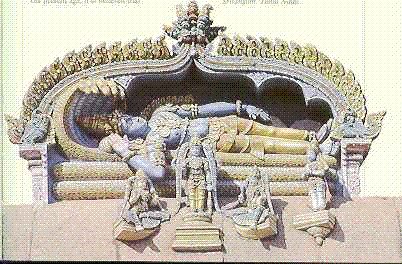
Lord Vishnu is said to rest in the coils
of Ananta, the great serpent of Infinity, while he waits for the universe to
recreate itself.
Refer
to Indian
Institute of Scientific Heritage and
Watch
Carl
Sagan and Hindu cosmology – video
***
For more than a century European and American scholars
have held to the conclusion that Indian astronomy must somehow have been
borrowed from the Greeks following the invasion of Alexander the Great, even
though the Indians have no tradition of this, and Indian astronomy has a form
quite unlike Greek astronomy. This conclusion is supported by the following
facts:
- there was extensive trade between India and the West
during the Hellenistic period
- Indian astronomical science is united with a form of
astrology very similar to that cultivated by the Greeks during the
Hellenistic period
- there are no historical records or accurate
chronology to substantiate the Indian's own traditions of the origin of
their astronomical science
-
These scholars concede that Hindu cosmological time
cycles, the form around which Indian astronomy is built, are indigenous to
Indian culture, but they believe them to be crude number speculations.
For many thousands of years, it is
argued, the mystics have had a cosmological and epistemological view
of things that the Western world is just beginning to understand.
Cosmologically, Western science has understood only recently that the
universe is extremely old. In 1965 the temperature of the universe was
measured for the first time, resulting in our present estimate of the
age of the universe as 15 billion years old. In the ancient literature
of the East one does not, of course, find such precise figures.
Instead there are analogies such as the following. Imagine an immortal
eagle flying over the Himalayas only once every 1,000 years; it
carries a feather in its beak and each time it passes, it lightly
brushes the tops of the gigantic mountain peaks. The amount of time it
would take the eagle to completely erode the mighty Himalayas is said
to be the age of the present manifestation of the universe. Such a
conception of time, which predates modern science by thousands of
years, is thought to be remarkable, especially when it is compared to
the slow realization of Western science and religion to the
possibility of a less humanlike time scale.
Eastern mysticism is also consistent
with the results of quantum physics. The mystics have always rejected
the idea of a hidden clocklike mechanism, sitting out there,
independent of human observation. The number one truth is that reality
does not consist of separate things, but is an indescribable,
interconnected oneness. Each object of our normal experience is seen
to be but a brief disturbance of a universal ocean of existence. Maya
is the illusion that the phenomenal world of separate objects
and people is the only reality. For the mystics this manifestation is
real, but it is a fleeting reality; it is a mistake, although a
natural one, to believe that maya represents a fundamental reality.
Each person, each physical object, from the perspective of eternity is
like a brief, disturbed drop of water from an unbounded ocean. The
goal of enlightenment is to understand this--more precisely, to
experience this: to see intuitively that the distinction between me
and the universe is a false dichotomy. The distinction between
consciousness and physical matter, between mind and body, is the
result of an unenlightened perspective.
***
Ancient
Indians already operated with a time span of astronomical proportions
long before the earliest signs of natural science in ancient Greece. It
is undeniable that ancient Indian texts present astonishingly exact
scientific calculations even by today's latest scientific standards,
such as the speed of light, exact size of the smallest particles and
the age of the universe.
The
Surya Siddhanta, a textbook on
astronomy of ancient India - last compiled in 1000 BC, believed by
Hindus to be handed down from 3000 BC by aid of complex mnemonic
recital methods still known today - computed
the earth's diameter to be 7,840 miles, the distance earth - moon
as 253,000 miles. These compare to modern measurements resp. as
7,926.7 miles and 252,710 miles for max. dist. moon-earth.
Manu's
texts in Sanskrit propounded evolution thousands of years before
Lamarck & Darwin. "The first germ of life was developed
by water and heat. Man will traverse the universe, gradually
ascending and passing through the rocks, the plants, the worms,
insects, fish, serpents, tortoises, wild animals, cattle, and
higher animals. These are the transformations declared, from the
plant to Brahma, which have to take place in the world."
Brihath
Sathaka operates with
divisions of the time of one day into:- 60 kalas or ghatika - 24
mins each. Subdivided into 60 vikala (24 secs.each) 60 para then
into tatpara, then into vitatpara then into ima then into
kasha.... the smallest unit, equal to approx. o.ooooooo3 of a
second (one 300 millionth). This smallest unit (3 X 10 -8 second)
is surprisingly close to the life-spans of certain mesons and
hyperons, according to some Western physicist who was interviewed
on the BBC World Service in the early 1990s.
The 14th century 'Rigveda
of the Sun' (dated by manuscript age only), says that the sun
covers 2,202 yoganas in half a mimesa - which calculates as
300,000 metres a second, fairly exactly the speed of light.
(source: Science,
the Critical mind and Dissent - By Robert C Priddy).
Speed
of Light:
One
such book is the celebrated commentary on the Rig
Veda by Sayana (c.
1315-1387), a minister in the court of King
Bukka I of the Vijayanagar Empire in South India. In
his commentary on the 4th verse of the hymn 1.50 of the
Rig Veda on the sun, he says:
Tatha
cha smaryate yojananam sahasre dve dve shate dve cha yogane ekena
nimishardhena kramamana namo ‘stu ta iti
Thus
it is remembered: O Sun, bow to you, you who travers 2,202 yojanas
in half a minute.
The
Puranas define 1 nimesha to be equal to 16/75 seconds. 1 yojana is
about 9 miles. Substituting in Sayana’s statement we get 186,000
per second.
Sayana’s
statement was printed in 1890 in the famous edition of Rig Veda
edited by Max Muller, the German Sanskritist . He claimed to have
used several three or four hundred year old manuscripts of
Sayana’s commentary, written much before the time of Romer.
Further support for the genuineness of the figure in the ancient
book comes from one of the earliest Puranas, the Vayu,
conservatively dated to at least 1,500 years old. The Puranas
speak of the creation and destruction of the universe in cycles of
8.64 billion years, that is quite close to currently accepted
value regarding the time of the big bang.
(source:
The
Wishing Tree - By Subhash Kak p. 75 -
77).
***
Shri 108 & Other Mysteries
The
number 108 is very auspicious for Hindus. It is the number of
beads of a rosary and of many other things in Indian cosmology.
But why is this number considered to be holy?
The
answer to this mystery may lie in the fact that the ancient
Indians took this to be the distance between the earth and the sun
in sun-diameter units and the distance between the earth and the
moon in moon-diameter units.
Two
facts that any book on astronomy will verify :
Distance
between earth and moon = 108 times moon-diameter
Indian
thought takes the outer cosmology to be mirrored in the inner
cosmology of the human. Therefore, the number 108 is also taken to
represent the 'distance' from the body of the devotee to the God
within. The chain of 108 'links' is held together by 107 joints,
which is the number of marmas, or weak spots, of the body in Ayurveda.
We
can understand that the 108 beads of the rosary must map the steps
between the body and the inner sun. The
devotee, while saying beads, is making a symbolic journey from the
physical body to the heavens.
108
is a number which resonates throughout the universe, as this
shows. There are also several other numbers which are repeated
throughout creation.
The reason why we do our mantra jap 108 times is because its a
symbol of our journey towards our higher/spiritual self (sun) from
our material self (earth).
(source:
Shri
108 & Other Mysteries - By Subhash Kak - sulekha.com
and The
Cycle of Time).
Page < 1 2 3 >
|